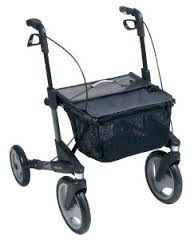Selecting a rollator
I have been going to the Chiltern Multiple Sclerosis Centre in Wendover, Bucks since 1997. All the rollators there that people use are Topro

Topro Olympus rollator
Its a fact of life
A couple of years ago in 2009 Louise Wakelam, Head of Professional services, suggested that I buy a rollator as a walking aid. I had developed a tendency to stagger and lurch when walking. I would trip up and fall over with increasing regularity, blame it on my poor balance and foot drop. At the end of the day I am disabled
Now it is a part of my life
She went so far as to recommend a specific one that would suit my requirements. I bought it, a Topro Rollator, and for a few months it sat in the hall gathering dust. Now in 2010 it is my preferred walking aid, always used when I go to the local shops, they are about 150 metres from the house. A rollator helps me to walk in a more natural posture, I feel secure and I do not feel as if I’m disabled, all of these are very important to me.
Rollators offer a better quality of life
The rollator was invented by the Swede Aina Wifalk in 1978. It could be described as a sophisticated and robust Zimmer frame on wheels, it provides support for disabled people when walking. A rollator has brakes that can be used to lock the wheels, this is essential when it is being used as a seat.
A few weeks ago I asked Louise how she selects the correct type of rollator for someone?
She will ask the following type of questions. Some of these questions are absurdly obvious and other ones are important and not so obvious.
- Why do you want a rollator and where do you intend to use it?
- Is it to be used indoors or outside the house? An outdoor rollator should have bigger wheels than an indoor one.
- A rollator will have a seat? Will the seat be big enough and strong enough to support your weight?
- Do you need a back support when sitting down?
- Are you able to use the brakes safely?
- Can it be adjusted to your height; you need to be standing upright when using it?
- How much support must the rollator provide when you are walking?
- Do you need it to turn corners and negotiate curbs and steps?
- Do you need to fold-up the rollator when it’s not being used?
- Will it need to be folded up so it can be put in the boot of the car?
- Can you lift it into the car?
- The width of the frame must also be thought about, for example your gait will affect the width
- What is the width of the rollator, and how wide are the doors in your house?
A rollator helps with your balance
A three wheel rollator would be suggested only if it is to be used indoors and the balance of the user is very good, unlikely to be an MS sufferer. 3-wheelers are very manoeuvrable but not stable if your balance is squiffy.
At first many people are reluctant to use a rollator because it brands them as being disabled; I was one of them. As a result it will sit in the hall gathering dust and you continue to stumble about using a couple of walking sticks to stop you falling over. Louise’s advice is to park the sticks and use the rollator. It helps you with your balance, you take more exercise, you are on your feet for longer and it makes you more confident.
A rollator gives you more confidence
Your muscles and skeleton are designed to move in a particular way, People with MS who are stiff and have difficulty walking will often break the rules of movement as defined by their skeleton; the result is that you often get chronic backache. Walking with a rollator will eliminate a lot of the backache, I know.
The final bit of advice, possibly the most important one, get professional advice. A rollator that does not suit your requirements is of no use whatsoever.
I would like to thank Louise Wakelam at the Chiltern MS Centre for her all her help.
Chilterns MS Centre, Oakwood Close, Wendover, Aylesbury, Buckinghamshire, HP22 5LX.
Read more at: http://www.chilternsmscentre.org/about-us/contact-us
Copyright © Chilterns MS Center.
Read more at: http://www.chilternsmscentre.org/about-us/contact-us
Copyright © Chilterns MS Centre
Telephone 01296 696133



A great article. Has re-assured me completely.
I have had RRMS for 18ys, and my main problems are, vertigo, drop foot and fatigue. Over the last 3 years i have fallen causing a broken ankle, a head injury and more recently a sprained ankle.
This week I purchased a Topro Troja, after much research. Im hoping my almost daily falls and balance will improve. I now need to be brave enough to use it out of the house without feeling upset about my disabilities.
Hello Clare,
Use it with pride.
It is no fun falling over, I have dislocated my left shoulder twice and had my left rotator cuff rebuilt last August. The thought of now breaking a bone now would be devastating. Have you thought of an FES (Functional Electrical Stimulator) or a Mumate for the foot drop and possibly an AFO (Ankle Foot Orthosis). There are articles about all three items on the website,
FES is the best bet but you’ve got to get funding
Good luck and keep your balance
Patrick
[…] I bought my first rollator in 2000 and used it when walking outside. Now I use one indoors as well. It helps me to keep my balance and minimises the number of falls. […]
lnteresting points – l now realise l need something that l can use ‘outdoors’
and l would like a seat – just in case – and a bag to carry things in – and it needs to be foldable to put into car.
Where should l go to find one suitable – are they available from OT.